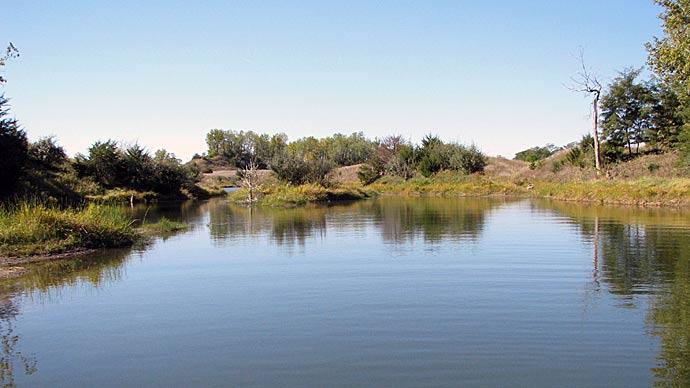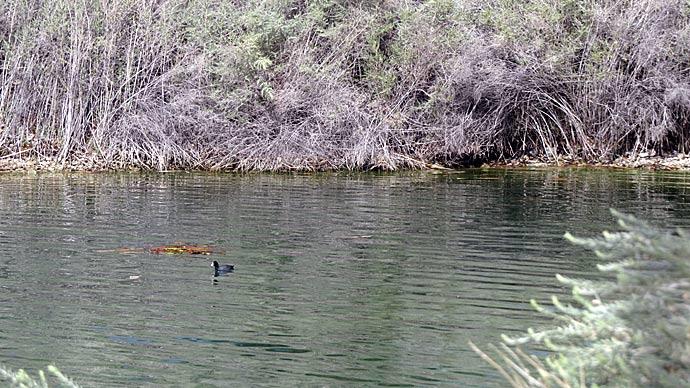
Fish mortalities are disturbing occurrences for sportfish pond owners. Naturally, when such an event happens, pond owners want to know why the mortalities occurred. In some cases, the answer is obvious, but in other instances, it is difficult to ascertain the cause with certainty.
The most common cause of fish kills, especially those in which fish were fine the day before and die overnight, is low dissolved oxygen concentration. Dissolved oxygen depletion has several causes, the most common one being too much phytoplankton. In this event, the amount of oxygen produced by phytoplankton photosynthesis usually exceeds the quantity of oxygen used in respiration by all organisms in the water column during the day. But, the amount of oxygen used at night by respiration of organisms (including phytoplankton) in the water column exceeds the amount of dissolved oxygen remaining from the previous day. As a result, dissolved oxygen concentration may fall below the level necessary for fish survival (about 1 or 1.5 mg/L for an exposure of a few hours).
Dissolved oxygen concentration might have been at acceptable concentration at dusk on the eve of the fish kill and at 8-10 AM on the morning of the event, but between these times, the dissolved oxygen concentration dropped to an unacceptable level. Thus, the timing of dissolved oxygen measurements is critical in determining if fish died of suffocation. Nevertheless, in a pond with a dense phytoplankton bloom, a large mortality offish in the morning is suggestive of oxygen depletion. Moreover, the presence offish gasping for air at the surface is a symptom of low dissolved oxygen concentration, but a word of caution is necessary. There are reasons other than low dissolved oxygen concentration for fish congregating in distress at the pond surface. High pH and various toxins also trigger this response.
Sudden mortality of phytoplankton (plankton die-offs) sometimes occurs in ponds with excessive phytoplankton and especially in ponds with dense blooms of blue-green algae (properly called cyanobacteria). During calm, clear weather, blue-green algae may float to the surface, forming dense scums. These scums have a high photosynthesis rate, resulting in elevated pH and extremely high dissolved oxygen concentration. This condition can stress algae physiologically and lead to mortality. Decomposition of large amounts of decaying algae consumes dissolved oxygen at a time when there are fewer algae to produce oxygen, and dissolved oxygen concentration declines. Pond water often appears brown, and there will usually be many small bubbles—apparently of carbon dioxide—at the surface. Depending upon how much phyto-plankton died, there may be no fish mortality, a partial fish kill, or almost complete fish mortality. After particularly severe phytoplankton die-offs, dissolved oxygen concentration may remain low for a week or more while the phytoplankton community becomes reestablished.
A cool weather front may pass through a region during the summer, bringing cold rain and heavy wind. This can cause thermal destratification of ponds with mixing of bottom water with surface water. Bottom water typically is devoid of dissolved oxygen and contains ferrous iron, other reduced inorganic substances, and organic matter. Bottom water dilutes dissolved oxygen in the surface water, and reduced ions and organic matter in bottom water further diminish dissolved oxygen concentration as they are oxidized. Pond water also may appear brown after such an event. Large fish mortalities may occur in some ponds, and it is not unusual for several ponds in an area to experience fish kills during the same weather event.
I have witnessed fish kills in ponds with dense infestations of underwater weeds after heavy rainfall events. Such ponds do not have abundant phytoplankton, and suspended soil particles in runoff from the watershed may cause sufficient turbidity in the pond to shade underwater weeds and reduce photosynthesis. This can result in oxygen depletion.
Applications of algicides and herbicides to control excessive phytoplankton or aquatic weeds also can lead to low dissolved oxygen concentration by reducing the amount of oxygen produced by photosynthesis during the time that dead plants are decomposing. This problem is worsened by an extended period of cloudy weather. A surgeon and pond owner once came to me and complained that his pond was choked with an obnoxious scum which turned out to be caused by the filamentous, mat-forming algae Pithophora. He likened the Pithophora to a cancer in his pond that needed cut out. I asked him if fishing was good, and he said that it was excellent. As it was early October, I suggested he ignore the Pithophora, and wait and see how bad it was the coming spring. In retrospect, this was similar to advice physicians often give their patients - wait and see what develops. He asked me where he could get the proverbial second opinion. I told him, and about two hours later he came by and thanked me, but said that my colleague recommended an algicide treatment. I replied that it was his pond, but I added that there was a hurricane scheduled to enter somewhere along the Louisiana, Alabama, or Florida coasts in a few days.
About two weeks later, the surgeon's son came by my office. He said, "I sure wish that my father was not so impetuous. He treated the pond with algicide, there were four days of cloudy weather, and all the fish died. We disposed of a dump truckload of dead fish including many bass over 5 pounds." Sometimes, it is best to leave well-enough alone!
Fish diseases also can cause mortality, but disease-related mortality is less common in sportfish ponds than in commercial, food-fish ponds such as channel catfish ponds. This relates to the lower density of fish in sportfish ponds, and the fact that environmental stress, a precursor to many fish disease episodes, is less in sportfish ponds. Disease-related fish mortality typically occurs over several days—even weeks—and single, massive mortality events are uncommon. When fish with lesions, in distress, or both are seen, and a few dead fish are observed daily, a sample of live fish exhibiting symptoms should be taken to a fish disease specialist for examination.
High concentrations of ammonia, nitrite, and hydrogen sulfide can cause fish kills, but such events are rare in sportfish ponds. Certain species of blue-green algae and golden algae produce toxins that can cause fish mortality. Fish kills related to algal toxins are difficult to verify with certainty. I once embarked on a study of algal toxicity in commercial catfish ponds in Alabama. I went to the specialist who made fish disease diagnoses for catfish farmers. I asked him how many cases of algal toxicity had been identified the previous year as I knew he kept records. He gave me a number, and explained that the number was arrived at by subtracting the number of disease cases diagnosed with certainty from the total numbers of cases investigated. In other words, if a definitive cause for mortality was not found, the mortality was chalked up to algal toxicity. My toxic-algae project was the biggest flop of any research project I ever conducted. We found not a single instance in which fish mortality could be definitely assigned to algal mortality; but, be assured, algal toxicity can and does occur.
Pollution by pesticides and other chemicals can cause fish kills in ponds. I once investigated a fish kill caused by a municipal sewer line leaking sewage in a pond. Decomposition of organic matter in the sewage caused oxygen depletion. Sources of pollution on watersheds of ponds always should be considered when other more obvious reasons for a fish kill are not found.
In summary, there are a multitude of reasons for mortalities in sportfish ponds. The most common reason is low dissolved oxygen concentration associated with dense blooms of phytoplankton and sometimes in combination with certain weather events. Pond owners should strive to maintain moderate blooms of phytoplankton by careful control of fertilizer applications. Installation of destratifiers in ponds also can prevent thermal stratification that is a factor in some fish kills. Sportfish pond owners who feed fish with commercial diets may want to follow the example of catfish farmers and install aerators in ponds.
Dr. Claude Boyd is a retired professor in the School of Fisheries, Aquaculture and Aquatic Sciences, Auburn University, Auburn, Alabama 36849. His work with water quality is internationally renowned. His most recent book, Handbook for Aquaculture Water Quality, is a must for anyone interested in learning about water chemistry and how it relates to your pond. It's technical, thorough, but easy to read and understand. Buy it at www.pondboss.com in the online store.
Reprinted with permission from Pond Boss Magazine



